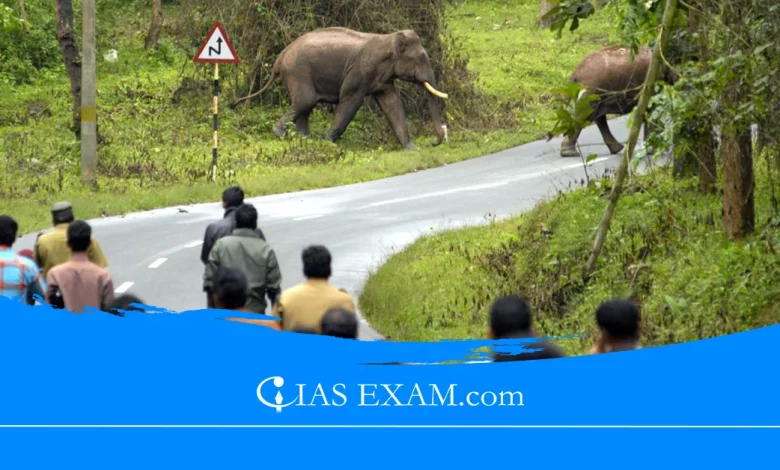
Context
Amid repeated deaths from animal attacks, Kerala declared man-animal conflict as a state-specific disaster, becoming the first state in the country to do so.
Case Study – Success Story of Kerala in Managing Man-Animal Conflict
- Kerala had about 5,700 (19% of national population of 30,000 in 2017) wild elephant population and elephants killed 2,036 humans in India (between 2018-2021) and Kerala accounted for only 81 (4%) of these deaths.
What has kept man-animal conflicts under control in Kerala?
- The boundaries between wasteland and civilization have mostly stayed unchanged in current years.
- Changes in agriculture practices. For instance, coffee, pepper, and tea plantations, where jumbos have little interest.
- Jumbos are named from their characteristics. Kabali, as an instance, is an elephant who lives in the Athirapally jungle in Thrissur district and is known to attack or chase automobiles.
Kerala’s Decision to Declare Man-Animal Conflict as a State-Specific Disaster
- At present, managing man-animal conflict is the obligation of the forest branch, which acts as according to the Wild Life Protection Act.
- Once the issue is declared a nation-specific catastrophe, the onus to cope with it shifts to the state catastrophe management authority, that’s powered by means of the Disaster Management Act and may take quicker and more decisive action.
- Every time a life has been lost to man-animal conflict, there has been a mounting pressure to tranquilise/seize/kill the animals accountable.
- At present, the chief wildlife conflictden (only one such post in the state) is the only authority to take a call on a wild animal wreaking havoc in human settlement.
- Also, in the past, the choice to tranquilise a killer animal, such as a wild elephant, has been questioned in court.
- Once the problem is under the disaster management authority, it may take movements overriding different norms, such as those under the Wildlife Protection Act.
- As per the Disaster Management Act, no court (except the SC or a HC) shall have jurisdiction to entertain any suit or proceeding in respect of anything done by relevant authorities in pursuance of any power conferred by this Act.
- The Act additionally says that the provisions of this Act can have an overriding impact on some other regulation throughout the specific period that a disaster has been declared.
About Man-Animal Conflict
-
- It relates to the interaction between wild animals and humans, in addition to the terrible outcomes for people, their resources, wild animals, and their habitats.
- Human-wildlife conflict has reached alarming ranges in states across India. For example,
- In Maharashtra, human-wildlife conflict brought about the death of 86 humans in 2021 and one hundred and five in 2022 – a steady increase compared with the remaining decade while common human deaths have been around 40.
- Causes:
-
-
- Growing populations of humans or animals overlap with established wildlife or human territory, resulting in a loss of sources.
- Habitat and corridor fragmentation as a result of legal and illegal land use changes, such as mining clearances or agricultural encroachment.
- Changing cropping patterns appeal to wild animals to agriculture.
- Habitat destruction due to the spread of invasive alien species, etc.
- India currently has more than 700 protected areas. However, 70% of elephant ranges, 40% of lion ranges and 35% of tiger ranges are outside protected areas (WWF).
- Ecologist Madhav Gadgil said the Wildlife Protection Act,1972 has enabled an environment wherein wild animals can invade human habitations with impunity.
-
- Solutions:
-
- Better enforcement and a realistic coverage: To cope with the problem will reduce incidences of man-animal conflict.
- Involvement of local communities: According to the Future for All Report 2021 (by WWF and UNEP), involving local communities will foster coexistence between people and the natural world, as it is not possible to absolutely do away with human-wildlife conflicts.
- Awareness campaigns: To teach, guide, and advise the overall public approximately man-animal conflict, including records dissemination through various types of media.
- Skill-improvement projects: People residing in and across the forest might gain from decreased pressures on both agricultural and forest land.
Source: The Indian express
UPSC Mains Practice Questions
Q.Examine the reasons for increasing incidents of man-animal conflict. Suggest some possible measures to tackle such issues. (250 words)





.png)



